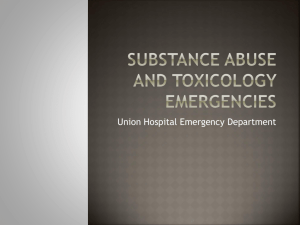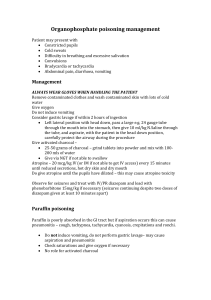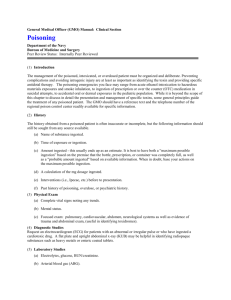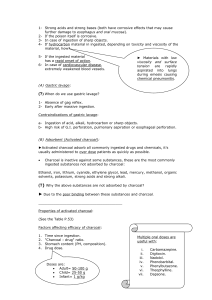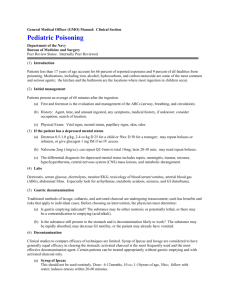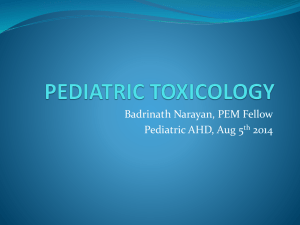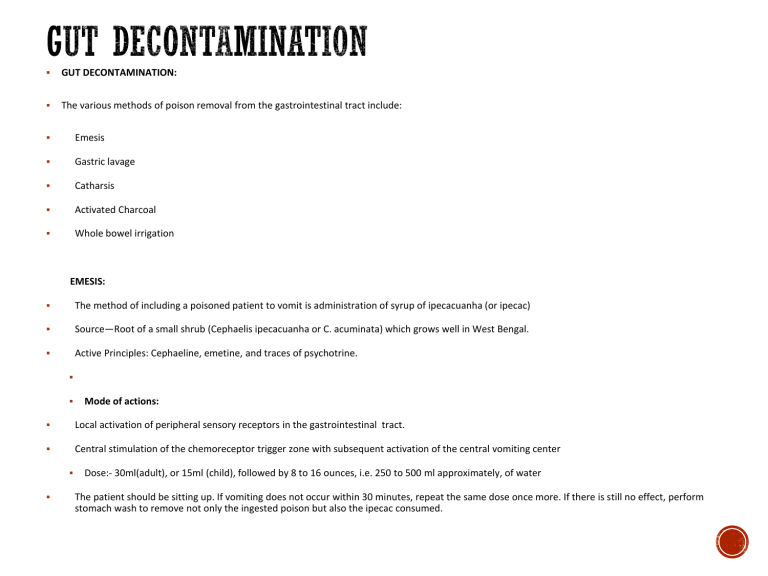
GUT DECONTAMINATION: The various methods of poison removal from the gastrointestinal tract include: Emesis Gastric lavage Catharsis Activated Charcoal Whole bowel irrigation EMESIS: The method of including a poisoned patient to vomit is administration of syrup of ipecacuanha (or ipecac) Source—Root of a small shrub (Cephaelis ipecacuanha or C. acuminata) which grows well in West Bengal. Active Principles: Cephaeline, emetine, and traces of psychotrine. Mode of actions: Local activation of peripheral sensory receptors in the gastrointestinal tract. Central stimulation of the chemoreceptor trigger zone with subsequent activation of the central vomiting center Dose:- 30ml(adult), or 15ml (child), followed by 8 to 16 ounces, i.e. 250 to 500 ml approximately, of water The patient should be sitting up. If vomiting does not occur within 30 minutes, repeat the same dose once more. If there is still no effect, perform stomach wash to remove not only the ingested poison but also the ipecac consumed. Complications: 1. Cardiotoxicity 2. Aspirations pneumonia 3. Oseophageal mucosal or Mallory Weiss tears Contra-indications: Very young (less than 1 year), or very old patients Pregnancy Heart Disease Bleeding diathesis Ingestion of cardiotoxic poison Time lapse of more than 6 to 8 hours GASTRIC LAVAGE Defined as “GI decontamination technique, that aims to empty stomach of toxic substances, by SEQUENTIAL ADMINISTRATION and ASPIRATION of small volumes of fluid via OROGASTRIC TUBE” Used for people, who: a) Have consumed a life-threatening dose b) Exhibit morbidity within 1-2 hours of ingestion Beyond 1-2 hours of ingestion, gastric lavage is permitted in the following conditions: a) Sustained release preparations b) Delayed gastric emptying Lavage should be considered only if a patient has ingested a life-threatening amount of a poison and presents to the hospital within 1 to 2 hours of ingestion. Precautions Never undertake lavage in a patient who has ingested a non-toxic agent Never use lavage as a deterrent to subsequent ingestions Contraindications Haemorrhagic diathesis, oesophageal varices, recent surgery, advanced pregnancy, ingestion of alkali, coma. Complications Aspirations pneumonia Laryngospasm Sinus bradycardia and ST elevation on the ECG Perforation of stomach or oesophagus(rare) CATHARSIS Catharsis is a very appropriate when used in connection with poisoning, since it means purification. It is achieved by purging the gastrointestinal tract (particularly the bowel) of all poisonous material. The two main group of cathartics* used in toxicology include. Ionic or Saline: These cathartics alter physico-chemical forces within the intestinal lumen leading to osmotic retention of fluid which attivates motility reflexes and enhances expulsion. Saccharides: Sorbitol (D-glucitol) is the cathartic of choice in adults because of better efficacy than saline cathartics, but must not used as far as possible in young children owning to risk of fluid and electrolyte imbalance (especially hypernatraemia) Contraindications: Corrosives Existing electrolyte imbalance Paralytic ileus Severe diarrhoea Recent bowel surgery Abdominal trauma Renal failure ACTIVATED CHARCOAL Activated charcoal is a fine, black odourless, tasteless powder made from burning wood, coconut shell, bone, sucrose, or rice starch, followed by treatment with an activating agent Dose:- 1 gm/kg body weight (usually 50 to 100 gm in an adult, 10 to 30 gm in a child). Contraindications Absent bowel sounds or proven ileus Caustic ingestion Ingestion of petroleum distillates. Mode of action Decreases the absorption of various poisons by absorbing them on to it’s surface. Activated charcoal is effective to varying extent, depending on the nature of substances ingested. Disadvantages Unpleasant taste Provocation of vomiting Constipation/diarrhoea Pulmonary aspiration Intestinal obstruction (especially with multiple-dose activated charcoal) WHOLE BOWEL IRRIGATION This is a method that is begin increasingly recommended for late presenting overdose when several hours elapsed since ingestion. It involves the instillation of large volumes of a suitable solution inti the stomach in a nasogastric tube over a period of 2 to 6 hours producing voluminous diarrhoea. Procedure Insert a nasogastric tube into the stomach and install one of the recommended solutions at room temperature, at a rate of 2 litres per hour in adult, and 0.5 litre per hour in children. The patient should preferably be seated in a commode. The use of metoclopramide IV, (10 mg in adults, 0.1 to 0.3 mg/kg in children) can minimise the incidence of vomiting. The procedure should be continued until the rectal effluent is clear which usually occurs in about 2 to 6 hours. Complications Vomiting Abdominal distension and cramps Anal irritation Contraindications Gastrointestinal pathology such as obstruction, ileus haemorrhage, or perforation
